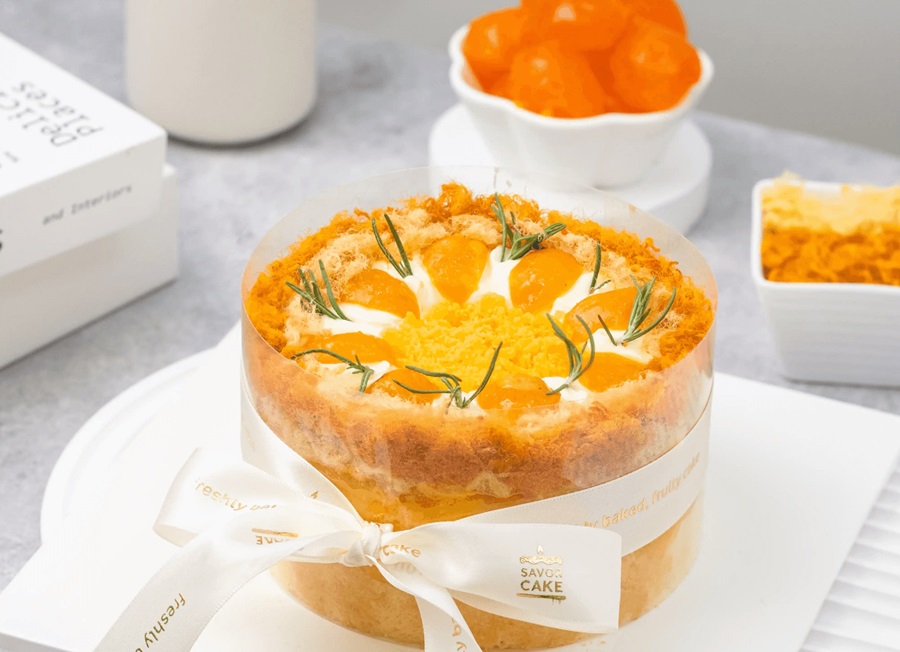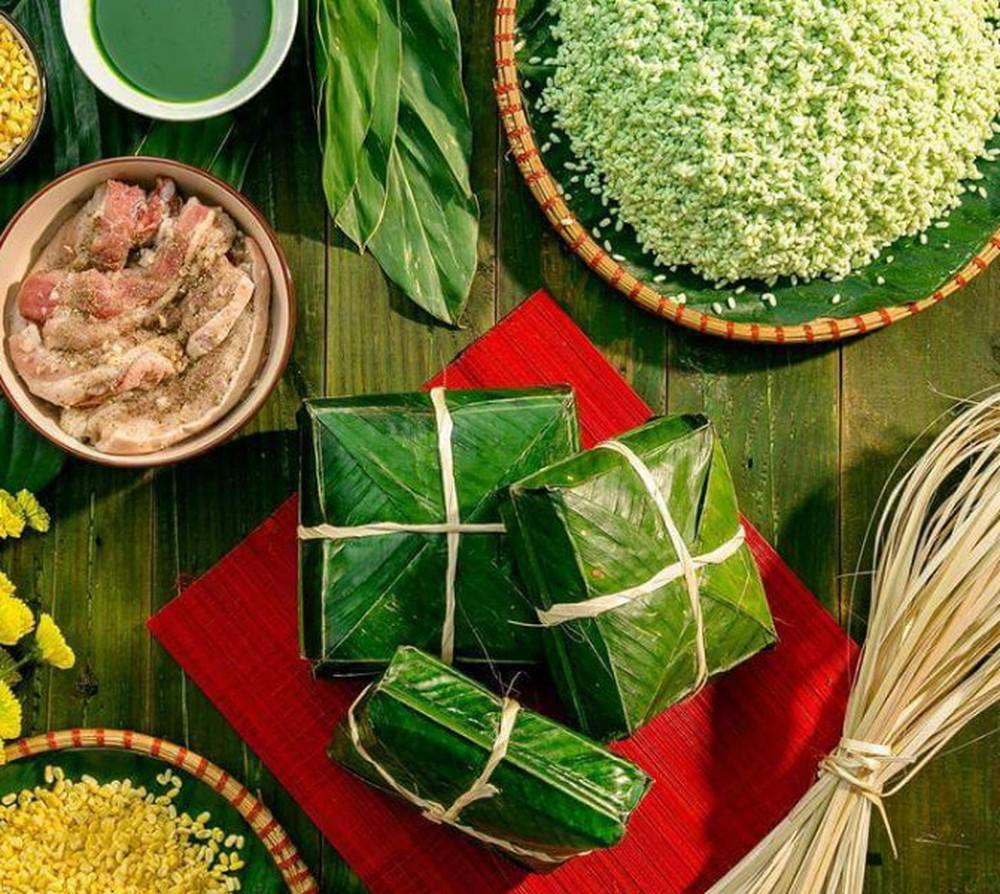Vietnamese sponge cake, or “bánh bông lan” in Vietnamese, is a testament to the country’s rich culinary heritage. This delectable treat boasts a light and fluffy texture and enticing flavors that make it a beloved dessert across Vietnam. Whether enjoyed in their traditional form or creatively adapted with unique twists, Vietnamese sponge cakes reflect the diversity and innovation of Vietnamese cakes. Scroll down for the recipes for 4-ingredient sponge cakes of Vietnam!
1. Key ingredients and calories of Vietnamese sponge cake
Vietnam stands out as a country boasting one of the world’s most diverse cuisines, with each region contributing unique characteristics. Variances in flavors, cooking techniques, and the captivating stories behind each dish further highlight the nation’s culinary diversity. And Vietnamese sponge cakes (banh bong lan) are a typical example.
A 3-ingredient sponge cake includes eggs, flour, sugar, and occasionally a touch of yeast or baking powder. This cake is a cherished sweet indulgence appreciated for its sweet and aromatic profile, soft texture, and luscious filling, primarily composed of egg whites, flour, and sugar.
Diverse and imaginative variations have sprung from the traditional Vietnamese sponge cake recipe. Elevating its flavor is possible by enjoying it with accompaniments like shredded pork floss, salted eggs, cheese, ice cream, avocado sauce, or dried fruits.
Vietnamese sponge cake calories prove challenging due to variables like size, ingredients, and composition. Nutrition experts suggest a 50-gram slice of banh bong lan registers at approximately 70-80 kcal. On average, 100 grams of this Vietnamese sponge cake contribute around 150 calories.
2. Tasty Vietnamese sponge cake recipes to try at home
Vietnamese sponge cake, a delightful treat originating from French cuisine, has undergone fascinating adaptations as it integrates into Vietnamese culinary traditions. Let’s explore the 4-ingredient sponge cake below.
2.1. Classic Vietnamese vanilla sponge cake
Classic Vietnamese sponge cake has a long history, dating to when chefs used only a whisk to beat eggs, baked the cake over charcoal, and lacked modern ovens or machinery. Nevertheless, the cakes were still fragrant, soft, and equally delicious. Those who don’t have an oven can still nail a classic Vietnamese sponge cake with the following recipe:
Ingredients:
- 300g chicken eggs (approximately 5 eggs)
- 300g finely ground sugar (adjustable based on sweetness preference)
- 200g all-purpose flour
- Optional: 2 vanilla pods, half an orange
Utensils:
- Handheld egg beater or egg whisk
- Electric rice cooker (or steamer)
- Mixing bowl or basin
Instructions:
- Step 1 – Prepare the wet mixture: Crack eggs into a bowl. For those using an egg whisk, add a pinch of salt and the juice of 1/3 of a lemon to facilitate foaming. Beat eggs with an electric egg beater for 30 seconds at low speed, gradually increasing to higher speed. After 2-3 minutes, when bubbles transition from large to small, slowly add sugar and beat until sugar dissolves. Add vanilla extract and the juice of half an orange for flavor enhancement (optional).
- Step 2 – Incorporate the wet and dry mixture: Slowly sift the flour into the mixture, stirring well with a spoon or flat spatula in one direction. This technique helps blend the flour evenly.
- Step 3 – Cook the cake: Preheat the rice cooker for 10 minutes, grease with oil or butter, pour in the batter, and press the cooking button 2-3 times (for regular cookers) or set the electronic cooker to cake-making mode. A toothpick should come out clean after approximately 45 minutes of cooking, indicating that the cake is done.
- Step 4 – Cool and serve: Allow the cake to cool for 15 minutes before flipping it onto a plate. Once cooled completely, decorate the cake to your liking, then put it in the fridge to chill. The cake is best enjoyed cold.
*Note: If you don’t have a rice cooker, a steamer also works for this recipe. Preheat the steamer and mold for 10 minutes, grease the mold, pour in the batter, and steam for 30-40 minutes. Use a toothpick or skewer to check if it is baked or not.
2.2. Vietnamese salted egg sponge cake (banh bong lan trung muoi)
The Vietnamese salted egg sponge cake is a unique culinary creation with extraordinary flavors. Unlike traditional Vietnamese sponge cakes, this variation introduces a savory element by incorporating matured and golden salted eggs.
The texture of the salted egg sponge cake is a key element of its appeal. The cake features a soft and velvety sponge, providing a delicate crumb that perfectly complements the richness of the salted eggs. Adding cheese and shredded pork floss adds layers of creaminess and chewiness, creating a delightful flavor profile.
Ingredients:
- For the cake base:
-
- 6 chicken eggs
- 1 teaspoon baking powder
- 120g all-purpose flour
- 20g cornstarch
- 120g sugar
- For the sauce:
-
- 1 egg yolk
- 25g sugar
- 3g salt
- 20g cornstarch
- 240ml water
- 25g unsalted butter (melted and cooled)
- For the cake filling:
-
- 7 salted egg yolks
- 2 small sausages
- 3 slices of “Con Bò Cười” cheese
- 50g pork floss
- “Mai Quế Lộ” wine (or white wine)
Instructions:
- Step 1 – Make the sponge cake: Prepare a bowl of water with a ratio of 2 cups of cold water to 3 cups of boiling water. Then, place 6 chicken eggs in the bowl and let them soak for about 5 minutes to warm the eggs, making them easier to whip. Whip the eggs with the sugar until fluffy. Sift and mix the flour, cornstarch, and baking powder. Fold into the egg mixture gently; pour into a lined rice cooker and cook. After 50 minutes, check if the cake is cooked by pressing gently on the surface to ensure the cake springs back. Let the cake cool for at least 15 minutes.
- Step 2 – Make the sauce: Clean salted egg yolks, soak in wine for 5 minutes, steam for 5 minutes, or bake at 170°C for 6-7 minutes. Mix sugar, salt, and an egg yolk; sift in the cornstarch. Then add water and melted butter. Heat in a pot and stir constantly until thickened.
- Step 3 – Prepare the filling: Take out the pork floss and cut the salted egg yolks and cheese into small pieces.
- Step 4 – Assemble and serve: Cut the cake in half, spread the sauce, layer with cheese and sausages, and top with the remaining half. Spread more sauce, and garnish with pork floss and more salted eggs.
2.3. Vietnamese banana sponge cake (banh bong lan chuoi)
Vietnamese banana sponge cake, distinguished by its soft and fluffy texture, offers a delectable experience that unfolds with each bite. Whether savored on its own or paired with a cup of Vietnamese coffee, this cake reflects Vietnam’s commitment to creating desserts that satisfy the taste buds and evoke a sense of cultural richness.
Ingredients:
- 300g bananas, peeled and cut into chunks
- 150g cake flour
- 3 eggs
- 100g cooking oil
- 5g baking soda
- 5g baking powder
- 100g fresh milk
- 190g all-purpose flour
Instructions:
- Step 1 – Make the wet mixture: Place the bananas in a large bowl with sugar, and use an electric mixer to beat until the mixture is smooth. Add one egg at a time, mix well after each addition. Stop when the mixture becomes fluffy, thick, and pale. Mix milk with cooking oil and slowly pour it into the bowl while beating to ensure that the ingredients blend into a uniform mixture.
- Step 2 – Combine the dry ingredients and mix the batter: Combine all-purpose flour, baking powder, and baking soda thoroughly. Gradually add the dry ingredients to the banana mixture bowl and beat again or fold to ensure a smooth, lump-free batter.
- Step 3 – Prepare to bake: To prevent sticking, grease the cake mold with butter or cooking oil. Line the bottom of the mold with a piece of parchment paper. Pour the banana sponge cake mixture into the mold, filling up to 2/3 of its capacity. Arrange a few banana slices on top for a visually appealing touch.
- Step 4 – Bake the cake: Preheat the oven to 190°C for about 15 minutes. Place the cake mold in the oven and bake for 15 to 20 minutes. Remove it from the oven when the cake emits a fragrant aroma and turns evenly golden brown.
2.4. Sponge cake of Cham people (ha nam can)
The “ha nam can” cake is a simple and traditional version of the Vietnamese sponge cake in An Giang. Crafting this cake is simple, requiring essential ingredients and a conventional kitchen setup with a sturdy pan. The critical components of “ha nàm căn” include wheat flour, duck eggs, toasted sesame seeds, and palm sugar.
Duck egg whites and yolks are vigorously beaten until foamy, then mixed with wheat flour and palm sugar to create a well-blended batter. While allowing the batter to rest, prepare thick aluminum pans on a hot stove. Simultaneously, a charcoal stove heats clay lids, shaping the cake into a pointed cone and enhancing its crispiness.
Once the batter is ready and the pans are uniformly hot, the cook applies a thin layer of oil to the pan and pours in the batter. Quickly, a layer of toasted sesame seeds is sprinkled to add texture and aroma to the cake. After about 5 minutes, the cake’s doneness is checked by inserting a bamboo stick into the center.
The “ha nam can” cake is round and palm-sized, which is very different from other Vietnamese sponge cakes. The crust is hot and crispy when freshly baked, while the inside is slightly fluffy and resilient.
To fully immerse yourself in Vietnamese cuisine, don’t miss the opportunity to savor an array of Vietnamese cakes that showcase the country’s culinary craftsmanship, including Vietnamese honeycomb cake, Vietnamese mung bean cake, Vietnamese banana cake, Vietnamese jelly cake, Vietnamese rice cakes, Vietnamese shrimp cake, etc. Each bite of these delicacies is a testament to the country’s culinary prowess and cultural richness.
The Vietnamese Sponge Cake is a testament to the rich tapestry of flavors and culinary expertise in Vietnamese desserts. While it originated in France, its journey to Vietnam has led to numerous adaptations influenced by the local culinary style and tastes. If you find yourself in Vietnam, trying these delicacies is a must. For those who have yet to make plans to visit, the simple recipes provided here make it easy for you to bake Vietnamese sponge cake at home.
For culinary enthusiasts, Vietnam is an absolute haven waiting to be explored. Whether in Hanoi, Hoi An, Nha Trang, or Phu Quoc, each city offers a delectable array of dishes ready to enchant even the most discerning taste buds. From the famous fish soup to the iconic pho, bun, traditional cakes, and beyond, Vietnam’s culinary landscape is a journey of endless delights.
After indulging in the gastronomic wonders, venture into a world of entertainment at VinWonders Wave Park & Water Park, VinKE & Vinpearl Aquarium, VinWonders Nam Hoi An, VinWonders Nha Trang, and VinWonders Phu Quoc. These extraordinary entertainment complexes offer diverse activities suitable for visitors of all ages. From thrilling rides and magnificent aquariums to safari parks and captivating shows, VinWonders guarantees limitless enjoyment for families and friends.
When it comes to accommodation, Vinpearl emerges as the top choice. As a premier hospitality brand in Vietnam, Vinpearl boasts branches in the most enchanting destinations, ensuring a restful stay that complements and enhances your overall journey.
>>> Book tickets to VinWonders Phu Quoc, Nha Trang, Nam Hoi An, VinKE & Vinpearl Aquarium, and VinWonders Wave Park & Water Park and craft your Vietnamese travel with joy and cheer!
 en
en





 Tiếng Việt
Tiếng Việt  中文 (中国)
中文 (中国)  한국어
한국어 

 22/12/2023
22/12/2023 171 views
171 views












![[Summer Sale -10%] Best-value Vinpearl Safari & VinWonders Phu Quoc combo tickets – Unlimited access now available](https://static.vinwonders.com/production/banner-336x160.jpg)


